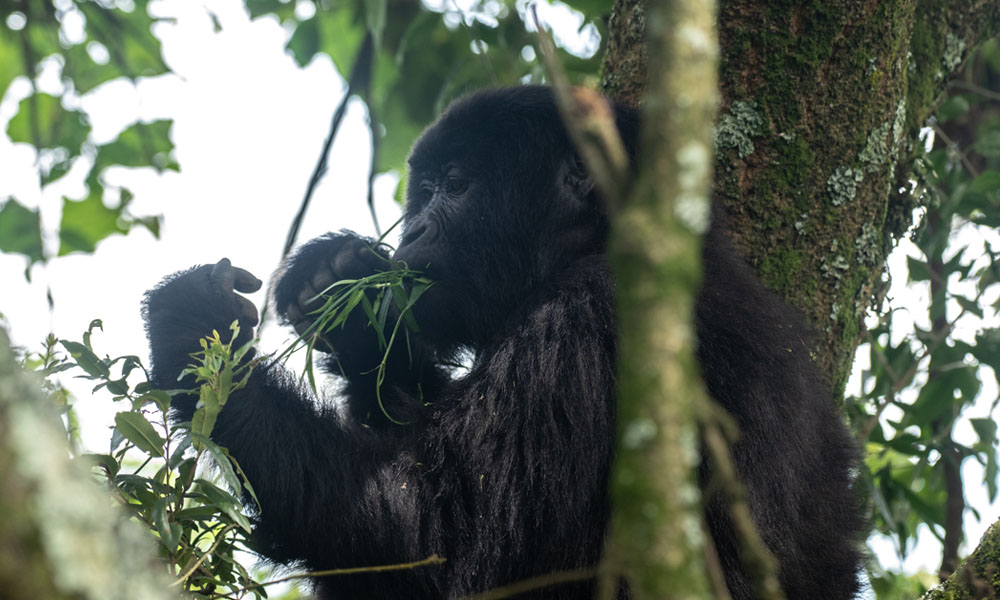Situated in the Kisoro district of South Western Uganda, Mgahinga Gorilla National Park occupies an area of around 33.7 square kilometres, making it the smallest park in Uganda. The most picturesque national park in Uganda is Mgahinga Gorilla National Park, which is adjacent to Bwindi Impenetrable Forest, another place where Uganda’s endangered mountain gorillas call home. The much larger Virunga Conservation Area, which encompasses neighbouring parks in Uganda, Rwanda, and the Democratic Republic of the Congo, includes Mgahinga National Park. Its borders are the Democratic Republic of the Congo’s Virunga National Park to the west and Rwanda’s Volcanoes National Park to the south.

Activities in Mgahinga Gorilla National Park
Gorilla Trekking
The most exciting activity in Mgahinga National Park is gorilla trekking, which is typically done daily. There is just one gorilla family where gorilla trekking is possible; this is the Nyakagezi gorilla family, which consists of more than 19 members. Trekking with the Nyakagezi family is an amazing experience that starts early at the Park headquarters (Ntebeko Visitor Centre) with a discussion of the dos and don’ts when going gorilla trekking. Trekking these rare and endangered gorillas in their natural habitat takes between one and five hours. Once you locate them, you are allowed to spend an hour with them, which is well worth the while. You will also come across other species while gorilla trekking, including buffaloes, elephants, golden and red-tailed monkeys, blue and white monkeys, and various bird and tree species.
Mountain Climbing
The most thrilling and daring sport is mountain climbing, which may be done on the three mountains that make up the Virunga volcano, Mt. Muhavura, Mt. Gahinga, and Mt. Sabinyo which borders the Democratic Republic of the Congo, Rwanda, and Uganda. The 4- to 8-hour walk to the summit provides the ideal experience and doesn’t require any climbing experience or equipment, but it does demand physical fitness. You will have the chance to simultaneously explore the three nations while at the peak, making it an unforgettable and fulfilling experience inside the Mgahinga Gorilla National Park.
Bird Watching
Over 250 bird species have been recorded in Mgahinga National Park, of which 79 are unique to Uganda. These bird species can be seen in the park’s bamboo forest, moorland zone, and Afro montane belt. Some of the bird species that can be seen here are the White-necked raven, Black kite, Pin-tailed whydah, Double-collared sunbird, Speckled mouse bird, Fire Finch, Stonechat, in the gorge between Mts. Sabinyo and Gahinga, and in the montane forest, where Rwenzori Turaco can be easily observed, among other bird species.
Nature Walks
Hikers can enjoy stunning scenic views of surrounding lakes like Lake Mutanda, agricultural areas, and forest bird species by trekking through the wild vegetation, bamboo forests, and Rugezi swamp, which is situated around the mountain’s edge. This is a very interesting activity.
Golden monkey trekking
The second most popular tourist activity in Mgahinga Gorilla National Park is golden monkey trekking. With over 5000 types of golden monkeys, the park is the ideal spot to see these endangered apes, who can be identified from other monkey species by their golden fur on the back. Unlike mountain gorillas, golden monkeys have larger social groups consisting of 60–80 members, which enhances the appeal and pleasure of interacting with them.
Cultural Encounters
The indigenous Batwa group has made Mgahinga National Park, with its thickets, their home. They live there, hunt, eat, and engage in all of their other activities in the forests. Visitors can therefore visit the Batwa homesteads while they are in Mgahinga to witness firsthand how they live, dress, eat, and dance among other aspects of their unique culture.
Best time to Visit Mgahinga National Park
The best months to go gorilla trekking and see golden monkeys in Mgahinga National Park are June through August and December through February. This is a better season to go gorilla trekking because there is less rain. While March through April and September through November are the finest months to observe birds, they are also the most wet. The mist and moisture during these months make it challenging to go on a gorilla trekking expedition.
